LAB 16 Internal Pelvic Dissection
Pelvic Neurovascular Structures
Lab Objectives:
• Study and review the sacrosciatic ligament.
• On the lateral side of the pelvis review the muscles of the pelvic diaphragm.
• Remove the left hemipelvis by pushing the pelvic viscera to the right side and then cutting through the pelvic symphysis and the upper part of the iliac shaft.
• On the inner surface of the equine pelvis find the following vessels: internal and external iliac vessels, cranial and caudal gluteal vessels, obturator and iliacofemoral arteries and the internal pudendal artery. On the mares find the uterine artery coming off the external iliac artery. On the ruminant pelvis find the long internal iliac artery (with a vaginal/prostatic branch) and its terminal branches, the caudal gluteal and internal pudenal vessels. If the specimen is a cow, look for the uterine artery coming off the internal iliac a. near its origin.
Anatomical Terms:
Osteology
dorsal & ventral sacral foramen
Internal Pelvic Vessels and Nerves
external iliac a.
deep circumflex iliac a.
uterine a. (horse)
internal iliac a.
caudal gluteal a.
cranial gluteal a.
obturator a. (eq)
internal pudendal a.
umbilical a.
uterine a. (ox)
urogenital (vaginal/prostatic) a.
sciatic n.
L6, S1 & S2 ventral branches to the sciatic n.
obturator n.
Internal Pelvic Structures
deep inguinal lymph node (bov)
internal obturator m. (eq)
Instructor Commentary:
In the horse the external iliac artery has two arterial variations worth noting: (1) the deep circumflex a. arises from this vessel instead of the terminal aorta and (2) the main uterine artery arises directly from the external iliac. Also, the horse has a small uterine artery from vaginal branch of the internal pudendal artery.
Typically the internal iliac artery branches into a parietal branch, the caudal gluteal a. and a visceral branch, the internal pudendal artery. The parietal branch is quite extensive in horses, a likely necessity to supply blood to their massive rump musculature. Unique equine vessels, not found in other domestic animals, are the obturator and iliacofemoral vessels. The obturator artery passes through the obturator foramen to supply blood to the abundant erectile tissue of the equine vascular type penis; this is in addition to the typical penile blood supply provided by branches of the internal pudendal artery near the ischial arch. In ruminants, the main uterine artery comes off the internal iliac a. close to its origin from the aorta. The internal iliac artery is very long and gives off the vaginal artery and terminal branches (internal pudendal and caudal gluteal arteries) near the lesser sciatic foramen. This foramen is easily palpated per rectum. In a pregnant cow this landmark will help you find the nearby pulsating internal iliac artery and trace it cranially to the main uterine artery.
There are two pudendal arteries, external and internal, but the pudendal n. is singular and is associated with the internal pudendal artery. In the bull the pudendal n. can be blocked with local anesthetic to drop the penis out of the prepuce (sheath) for examination and treatment.
The retractor and rectococcygeus muscles are unique smooth muscles because they attach to bone. Both muscles attach to the caudal vertebrae. The rectococcygeus muscle is formed by longitudinal smooth muscle fibers of the rectum that pass dorsocaudally to attach on the third caudal vertebrae (image 5).
Dissection Images:
Note: Click an image to see it enlarged, view its caption, and toggle its labels.
| 1 | 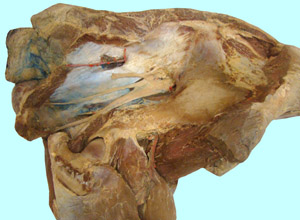 |
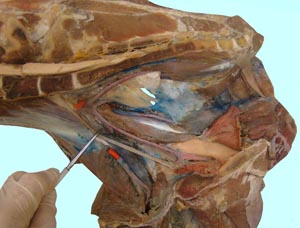 |
2 |
| 3 | 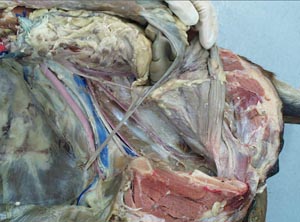 |
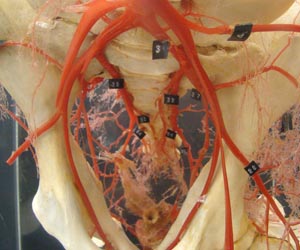 |
4 |
| 5 |  |
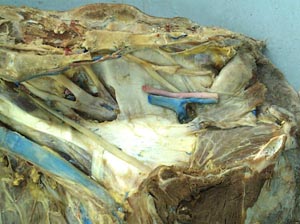 |
6 |
